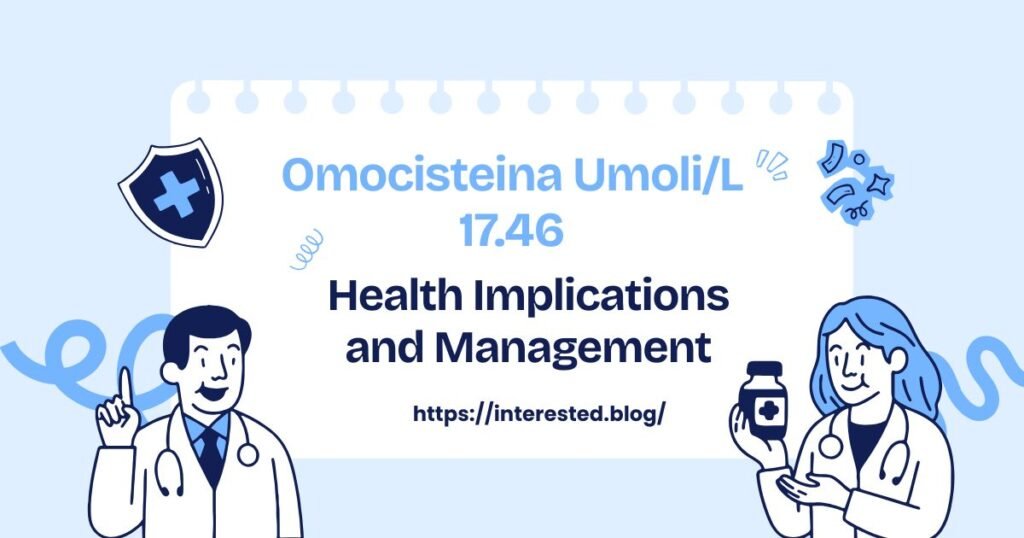Introduction
Homocysteine, often discussed in health circles, is an amino acid found in the blood, produced when your body breaks down another amino acid, methionine. It’s essential for several bodily functions, but it’s not a nutrient you’d normally think about unless there’s a health issue. So, why should you care about a specific measurement like “Omocisteina Umoli/L 17.46”?
Well, elevated homocysteine levels can signal potential health risks, particularly for the cardiovascular system, mental health, and even pregnancy. Specifically, a level of 17.46 µmol/L is considered high and may require further attention.
Why This Specific Level Matters
A homocysteine level of 17.46 µmol/L is considered elevated, and it may indicate an increased risk for various health conditions. Keeping track of your homocysteine levels, especially if they go above normal ranges, can be an essential part of maintaining good health.
The Role of Homocysteine in the Body
Homocysteine is a naturally occurring amino acid, but it needs to be kept in check. Here’s a breakdown of how it functions in the body and why maintaining normal levels is crucial.
Biochemistry Behind Homocysteine
Homocysteine is produced when the body processes methionine, an amino acid found in meat and other protein-rich foods. Under normal conditions, homocysteine is either converted into other substances, like cysteine (another amino acid), or recycled into methionine through a vitamin-driven process involving B vitamins.
Key Functions and Processes Involving Homocysteine
While homocysteine plays a role in some metabolic processes, its real importance lies in the balance of its levels.
When homocysteine levels rise too much, it can damage blood vessels and increase the risk of clotting. This is why elevated homocysteine, like the 17.46 µmol/L level, should not be ignored.
What Happens When Homocysteine Levels Become Abnormal?
When homocysteine levels rise beyond the normal threshold (usually between 5-15 µmol/L), it can have serious consequences. These consequences include:
- Blood vessel damage
- Increased clotting risk
- Potential cardiovascular diseases
A sustained high level of homocysteine is also linked with a higher likelihood of developing strokes, heart attacks, and other serious health problems.
Omocisteina Umoli/L 17.46: Is It a Cause for Concern?
At Omocisteina Umoli/L 17.46, homocysteine levels are above normal, signaling potential risk factors that could require attention. But what exactly makes this specific level a concern?
Defining the Threshold for Normal Homocysteine Levels in the Blood
- Normal Range: 5-15 µmol/L
- Elevated Range: Anything above 15 µmol/L can be classified as elevated.
When you reach 17.46 µmol/L, you are in a danger zone that should prompt action. But what exactly can go wrong?
Understanding Why 17.46 µmol/L is Significant
This level signifies that homocysteine is not being adequately processed, potentially leading to health complications. It can affect the cardiovascular system, increase the risk of blood clots, and put stress on your kidneys.
Potential Symptoms of High Homocysteine Levels
While there may not always be immediate symptoms, some signs that could be linked to high homocysteine levels include:
- Fatigue
- Shortness of breath
- Chest pain
- Cognitive difficulties (memory issues)
If you experience any of these symptoms alongside an elevated homocysteine level, it’s a good idea to consult a healthcare professional.
What Causes Elevated Homocysteine Levels?
Understanding the root causes of elevated homocysteine can help you manage the condition better. Let’s take a look at the factors that contribute to this health risk.
Genetic Factors Contributing to Elevated Homocysteine
Some people inherit genetic mutations that affect the enzymes responsible for processing homocysteine, leading to elevated levels. The most common genetic cause is a mutation in the MTHFR gene, which plays a crucial role in converting homocysteine into other beneficial compounds.
Lifestyle and Dietary Influences
A poor diet or unhealthy lifestyle choices can significantly increase homocysteine levels. For example:
- Dietary Deficiencies: Lack of B vitamins (B6, B12, and folate) can hinder the conversion of homocysteine into other substances.
- Poor Lifestyle: Smoking, excessive alcohol consumption, and physical inactivity can all contribute to high homocysteine levels.
Common Medical Conditions Associated with High Homocysteine
Certain medical conditions can also elevate homocysteine, including:
- Kidney disease
- Hypothyroidism
- Diabetes
Managing these underlying conditions can help in regulating homocysteine levels.
How Omocisteina Umoli/L 17.46 Affects Your Cardiovascular Health

Elevated homocysteine levels, like those around 17.46 µmol/L, are strongly linked to heart health. Here’s why.
The Link Between Elevated Homocysteine and Heart Disease
Homocysteine can cause damage to the lining of blood vessels, leading to plaque buildup and increased risk of heart disease. High homocysteine is also thought to make the blood more prone to clotting, further increasing the risk of heart attacks and strokes.
Mechanisms by Which High Homocysteine Damages Blood Vessels
- Oxidative Stress: Elevated homocysteine levels cause oxidative damage to blood vessels, making them more susceptible to plaque buildup.
- Thrombosis: High homocysteine promotes clot formation, which can block blood flow and cause heart attacks or strokes.
Research Findings on Omocisteina Umoli/L 17.46 and Heart Attack Risk
Studies show that homocysteine levels above 15 µmol/L increase the risk of a heart attack by promoting blood clotting and damaging the blood vessels. In fact, one study found that people with high homocysteine levels were 50-100% more likely to have a heart attack than those with normal levels.
The Connection Between Omocisteina Umoli/L 17.46 and Stroke Risk
High homocysteine is a well-established risk factor for strokes, and the 17.46 µmol/L level could indicate an elevated risk.
How Elevated Homocysteine Can Lead to Stroke
Homocysteine can cause the narrowing of blood vessels and promote clotting. This combination can block blood flow to the brain, increasing the risk of stroke. The 17.46 µmol/L threshold suggests a higher-than-average chance of such events occurring.
Understanding the Stroke Risk and Omocisteina Umoli/L 17.46 Levels
The risk of stroke escalates with elevated homocysteine. This risk is especially true for individuals with other predisposing factors, such as high blood pressure or a family history of strokes.
Studies Exploring the Homocysteine-Stroke Relationship
A multitude of studies has found that homocysteine levels above 15 µmol/L correlate with a higher risk of stroke. Maintaining healthy homocysteine levels, therefore, could be an effective strategy for stroke prevention.
Omocisteina Umoli/L 17.46 and Mental Health: The Hidden Link
Did you know that homocysteine isn’t just about heart disease? High levels can also affect your brain health, leading to cognitive problems and mental health issues.
The Impact of High Homocysteine on Brain Health
Homocysteine has been shown to affect brain function, increasing the risk of cognitive decline and mental health disorders like depression and anxiety.
Link Between Elevated Homocysteine and Cognitive Decline
Research has found that individuals with elevated homocysteine are at a higher risk of developing Alzheimer’s disease and other forms of dementia.
Potential Connection with Mental Health Disorders
High homocysteine levels could contribute to depression, memory issues, and mood disorders due to the damage it causes to brain cells and neurotransmitters.
Pregnancy and Elevated Homocysteine: What You Need to Know
When you’re pregnant, your body goes through a lot of changes. One area that may be affected is your homocysteine levels, and elevated levels can pose specific risks.
How Omocisteina Umoli/L 17.46 Affects Pregnancy
Elevated homocysteine in pregnancy can lead to complications like preeclampsia, miscarriage, or placental abruption. Therefore, maintaining normal homocysteine levels is crucial for both maternal and fetal health.
Risks of Elevated Homocysteine During Pregnancy
Research suggests that high homocysteine levels can lead to preterm delivery, fetal growth restriction, and other pregnancy complications. Monitoring and addressing elevated levels early in pregnancy can mitigate these risks.
Recommendations for Pregnant Women with Elevated Homocysteine
Pregnant women with elevated homocysteine may be advised to take supplements like folate, B6, and B12 to help lower their levels. A healthcare provider can help create a plan to keep levels within a healthy range during pregnancy.
Nutritional Deficiencies That Contribute to High Homocysteine
One of the primary factors influencing homocysteine levels is diet, specifically a lack of certain essential nutrients. Here’s how nutritional deficiencies play a key role in elevated homocysteine levels.
The Role of B Vitamins (B6, B12, Folate) in Regulating Homocysteine Levels
- Vitamin B6, Vitamin B12, and folate are essential in the conversion of homocysteine into other substances that the body needs. Without adequate amounts of these vitamins, the body struggles to process homocysteine efficiently, leading to its accumulation in the blood.
- Folate is particularly important in breaking down homocysteine, while B6 and B12 help maintain this process by converting it into substances that are either safe for the body or useful for other metabolic pathways.
Deficiencies in These Nutrients and Their Effects on Omocisteina Levels
A deficiency in any of these B vitamins can result in elevated homocysteine levels. For example:
- Vitamin B12 Deficiency: This can lead to severe cognitive issues, nerve damage, and an increase in homocysteine levels.
- Folate Deficiency: Folate is especially vital in reducing homocysteine levels, and without it, the blood becomes prone to high homocysteine, potentially leading to cardiovascular problems.
How to Prevent Deficiencies to Maintain Normal Homocysteine Levels
A well-balanced diet is key to maintaining appropriate homocysteine levels. Foods rich in B vitamins—such as leafy green vegetables, legumes, eggs, dairy, meat, and fortified cereals—can help keep these levels in check. In some cases, supplements may be necessary, especially for those who are vegetarian or have malabsorption issues.
Key Tests to Monitor Omocisteina Umoli/L 17.46 Levels
If you’re concerned about your homocysteine levels, testing is the first step in determining whether your levels are within the normal range or if they require intervention.
Understanding Blood Tests for Homocysteine
A simple blood test measures the amount of homocysteine in your bloodstream. It’s typically done after fasting for at least 8 hours to ensure accuracy. The results will show whether your homocysteine levels are normal, elevated, or in a potentially dangerous range.
When Should You Get Tested for Homocysteine Levels?
Testing is typically recommended if you have a family history of heart disease, stroke, or other cardiovascular issues. It’s also advisable if you:
- Are over the age of 40
- Have high blood pressure, diabetes, or kidney disease
- Are experiencing unexplained cardiovascular symptoms
Interpreting Your Lab Results and What Omocisteina Umoli/L 17.46 Means
- Normal Level: 5-15 µmol/L
- Elevated Level: Anything above 15 µmol/L, especially reaching the 17.46 µmol/L mark, may be a cause for concern and warrant further investigation.
If your test results show elevated levels, your doctor may suggest a combination of lifestyle changes, dietary adjustments, or supplements to help lower your homocysteine.
Lifestyle Changes to Manage Elevated Omocisteina Umoli/L 17.46
When you have elevated homocysteine levels, making certain lifestyle changes can significantly help in managing and reducing them.
Dietary Changes That Help Lower Homocysteine
Eating a diet rich in fruits, vegetables, whole grains, and lean proteins can help manage your homocysteine levels. Key dietary strategies include:
- Increasing intake of leafy greens (rich in folate)
- Consuming whole grains and legumes (for B6)
- Eating meat, fish, and eggs (for B12)
Benefits of Regular Physical Activity for Controlling Homocysteine
Exercise has been shown to lower homocysteine levels. Regular physical activity, such as walking, swimming, or cycling, promotes healthy circulation and overall well-being, which can help in managing homocysteine levels.
How Stress and Sleep Affect Omocisteina Levels
Chronic stress and poor sleep can elevate homocysteine levels by increasing inflammation and oxidative stress in the body. Ensuring that you manage stress through relaxation techniques and getting quality sleep each night can help lower homocysteine.
The Role of Supplements in Reducing Omocisteina Umoli/L 17.46
In some cases, diet and lifestyle changes may not be enough to lower elevated homocysteine levels. This is where supplements come in.
The Importance of B Vitamins (B6, B12, and Folate) for Managing Homocysteine Levels
As mentioned earlier, B vitamins play a crucial role in regulating homocysteine. Supplementing with:
- Folate (Vitamin B9)
- Vitamin B6
- Vitamin B12
…can significantly reduce homocysteine levels and improve overall health. In particular, folate supplementation is often recommended for those with elevated homocysteine levels.
Are Supplements Effective in Lowering Elevated Homocysteine?
Yes, studies have shown that B vitamin supplements can effectively lower homocysteine levels. However, they are most effective when combined with other lifestyle changes, such as dietary improvements and regular exercise.
How to Choose the Right Supplement for Lowering Omocisteina Levels
Consult with a healthcare provider to choose the right supplement. Be sure to take supplements that contain the active forms of the vitamins (e.g., methylcobalamin for B12) for better absorption and efficacy.
Treatment Options for High Omocisteina Levels
When lifestyle changes and supplements alone aren’t enough, medical treatment may be required to manage high homocysteine levels.
Medical Interventions and Treatments for Managing Elevated Homocysteine
Doctors may prescribe medications or additional treatments to help lower homocysteine, particularly in cases where lifestyle changes are not sufficient. Medications like beta-blockers or aspirin may be used for related cardiovascular risks, while folic acid supplementation remains the cornerstone of treatment for high homocysteine.
Prescription Medications Versus Natural Remedies
While natural remedies, including dietary changes and supplements, are effective, some patients may require prescription medications, especially if they have underlying conditions like heart disease or kidney issues.
How Doctors Approach Treatment for High Homocysteine Levels
A doctor will assess your overall health, medical history, and lifestyle factors to determine the best treatment plan. They may recommend:
- Folate supplements for individuals with deficiencies
- B6 and B12 for those with metabolic issues
- Medications for individuals with cardiovascular risks
Omocisteina Umoli/L 17.46 in Aging Populations: Risks and Prevention

As we age, our bodies undergo many changes, and elevated homocysteine levels can become a significant health concern. Here’s what to know about the risks in older adults.
Why Older Adults Are More Likely to Have High Homocysteine Levels
Aging is often associated with a decline in the body’s ability to process homocysteine, and as a result, levels can rise. The loss of muscle mass, impaired kidney function, and reduced absorption of nutrients all contribute to higher homocysteine levels in older adults.
The Role of Omocisteina in Age-Related Diseases Like Alzheimer’s and Osteoporosis
High homocysteine is linked to cognitive decline, Alzheimer’s disease, and even osteoporosis in older adults. It accelerates the process of neurodegeneration and affects bone health by interfering with collagen and bone density.
Preventative Strategies for Older Adults
Older adults can benefit from early testing, regular exercise, and a nutrient-dense diet to lower homocysteine levels. Supplements like folate, B12, and B6, along with weight-bearing exercise, can prevent or mitigate the impacts of aging on homocysteine metabolism.
How Omocisteina Umoli/L 17.46 Affects Kidney Health
Elevated homocysteine levels can be particularly damaging to the kidneys. Understanding the connection is crucial for managing overall health.
The Relationship Between Elevated Homocysteine and Kidney Disease
High homocysteine levels are associated with kidney disease because they contribute to inflammation and endothelial dysfunction. This can damage the kidney’s blood vessels and lead to kidney failure.
How Kidney Disease Impacts Homocysteine Metabolism
Kidney disease impairs the body’s ability to process homocysteine, which results in elevated levels. Managing kidney health and homocysteine levels is crucial for preventing further complications.
Preventing Kidney Damage with Proper Management of Homocysteine Levels
Early detection of elevated homocysteine and kidney issues can help reduce the risk of kidney failure. Doctors may recommend dietary changes, medications, or lifestyle adjustments to help maintain kidney function and normal homocysteine levels.
Gender Differences in Homocysteine Levels and Health Risks
Homocysteine levels don’t affect everyone the same way. In fact, men and women may experience different risks related to elevated levels.
How Omocisteina Umoli/L 17.46 Levels Differ Between Men and Women
Research has shown that men tend to have higher homocysteine levels than women, particularly before menopause. After menopause, women’s homocysteine levels tend to increase, potentially due to the loss of estrogen’s protective effects on homocysteine metabolism.
Gender-Specific Risks Related to High Homocysteine Levels
For men, high homocysteine is a significant risk factor for heart disease, while for women, it may also increase the risk of stroke and cognitive decline. Gender-specific treatment strategies may be necessary to manage these risks.
Understanding Hormonal Influences on Homocysteine Metabolism
Hormonal fluctuations in women, especially after menopause, can have a significant impact on homocysteine metabolism. Understanding this connection helps in developing gender-specific treatments.
Omocisteina Umoli/L 17.46 and Diabetes: A Risk Factor for Complications
Diabetes is a condition that can have wide-reaching effects on many aspects of health, including homocysteine levels. Here’s why elevated homocysteine levels in diabetic patients should not be overlooked.
The Link Between High Homocysteine and Diabetes Complications
People with diabetes often have higher homocysteine levels due to insulin resistance and poor blood sugar control. Elevated homocysteine in diabetic patients increases the risk of several complications, such as:
- Cardiovascular diseases (heart attack, stroke)
- Kidney disease (diabetic nephropathy)
- Neuropathy (nerve damage)
High homocysteine can further complicate these conditions, making management of diabetes even more challenging.
How Diabetes Affects Homocysteine Levels
In diabetes, the body’s inability to regulate blood sugar can lead to oxidative stress and inflammation, both of which can increase homocysteine levels. Additionally, diabetes can impair kidney function, reducing the ability to process homocysteine effectively.
Strategies to Control Homocysteine in Diabetic Patients
To manage elevated homocysteine levels, diabetic patients should focus on:
- Tight blood sugar control: Keeping blood glucose within a healthy range is key to preventing an increase in homocysteine.
- Regular monitoring of homocysteine levels: Periodic testing can help track changes and assess risk.
- Supplementation with B vitamins: Especially folate and B12, to support proper homocysteine metabolism.
High Omocisteina Levels and Bone Health: The Lesser-Known Connection
Bone health isn’t something most people think of when discussing homocysteine, but elevated levels of this amino acid can have a significant impact on your bones.
Impact of Elevated Homocysteine on Bone Density and Fractures
High homocysteine levels can interfere with collagen synthesis, a protein essential for bone strength. This disruption increases the risk of:
- Osteoporosis: A condition where bones become weak and brittle.
- Bone fractures: Elevated homocysteine has been linked to increased fracture risk, especially in postmenopausal women.
How to Manage High Homocysteine for Better Bone Health
Managing homocysteine levels is one piece of the puzzle in maintaining bone health. Here are some strategies:
- Adequate calcium and vitamin D intake to support bone health.
- Regular weight-bearing exercise, which strengthens bones.
- B vitamin supplementation, particularly folate, B6, and B12, to regulate homocysteine levels.
Taking these steps can reduce the likelihood of osteoporosis and bone fractures, especially as you age.
Monitoring Your Omocisteina Umoli/L 17.46 Over Time: What to Expect
If you’ve already been tested for homocysteine and have received a level of Omocisteina Umoli/L 17.46, regular monitoring is essential to track your health and make necessary adjustments.
How Frequently Should You Test Your Homocysteine Levels?
For those with elevated homocysteine levels, it’s important to have regular tests—typically once every 3 to 6 months. If you are making lifestyle changes or taking supplements to lower your levels, more frequent testing may be needed to assess progress.
The Progression of Elevated Homocysteine and Health Outcomes
If high homocysteine levels go unchecked, it may lead to the progression of cardiovascular diseases, strokes, and even cognitive decline. Regular monitoring will help identify whether your efforts to manage your levels are working or if adjustments are needed.
Tips for Long-Term Monitoring and Lifestyle Management
- Keep a health journal: Track changes in diet, exercise, and medication to see what works best.
- Consult with your healthcare provider regularly: Ensure that any treatments or interventions are effective.
- Make consistent lifestyle changes: Focus on a healthy diet, regular exercise, and stress management.
Common Myths About Omocisteina Umoli/L 17.46 You Need to Stop Believing
There are many myths surrounding homocysteine and its health impacts. Let’s clear up some common misconceptions.
Debunking Misconceptions About Elevated Homocysteine
- Myth 1: Elevated homocysteine is only a problem for people over 60.
- Fact: Elevated homocysteine can affect anyone, and the risks increase with age, but younger individuals with certain genetic conditions or lifestyle factors can also experience elevated levels.
- Myth 2: High homocysteine is caused by high protein consumption.
- Fact: While methionine, a protein amino acid, contributes to homocysteine levels, the real problem arises when the body doesn’t have enough B vitamins to process homocysteine effectively.
- Myth 3: Elevated homocysteine only affects heart health.
- Fact: Elevated homocysteine also impacts brain health, bone density, kidney function, and more.
- Myth 4: You can lower homocysteine levels with diet alone.
- Fact: While diet is crucial, sometimes supplements or medical treatments are required, especially in individuals with genetic mutations affecting homocysteine metabolism.
Addressing Common Misunderstandings in the Medical Community
Even within the medical community, there are debates about how aggressively homocysteine should be managed. However, research consistently shows that elevated levels are a serious health risk and should be monitored and addressed, particularly when levels like 17.46 µmol/L are present.
Final Thoughts
Taking control of your health begins with understanding your homocysteine levels. Elevated levels, like 17.46 µmol/L, can be a sign of underlying health risks, but with proper lifestyle management, diet, and, if necessary, supplements or medical intervention, you can manage these levels effectively. By staying proactive and informed, you can reduce your risk of serious health issues and enjoy a healthier, more vibrant life.
FAQs About Omocisteina Umoli/L 17.46
Q. What is a normal homocysteine level?
A normal homocysteine level is between 5-15 µmol/L. Anything above 15 µmol/L is considered elevated and may require further investigation.
Q. How can I lower my homocysteine levels naturally?
Eating a diet rich in B vitamins (B6, B12, folate), exercising regularly, and managing stress are key natural strategies to lower homocysteine levels.
Q. Can high homocysteine levels cause a heart attack?
Yes, elevated homocysteine levels can damage blood vessels, promote clotting, and increase the risk of heart attacks and other cardiovascular diseases.
Q. Do supplements help in reducing homocysteine levels?
Yes, supplements containing folate, B6, and B12 are effective in lowering homocysteine levels, particularly for individuals with deficiencies.
Q. Is homocysteine testing necessary for everyone?
While not necessary for everyone, testing is recommended for individuals with a family history of cardiovascular disease, diabetes, or other risk factors associated with high homocysteine levels.
Read More Content: Negin Behazin MD


